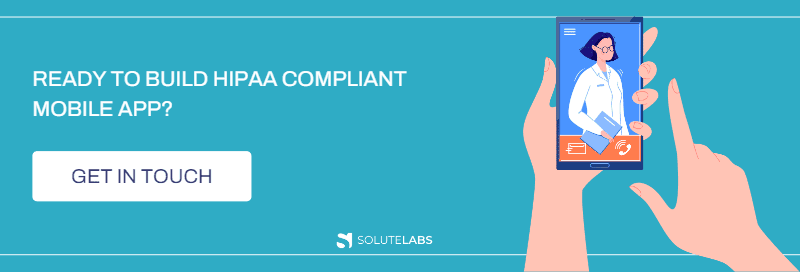As technology advances, healthcare is not an exception to the increasing demand for mobile applications. The use of mobile applications in healthcare has become more popular with the advent of telemedicine and the pandemic. These apps not only help patients manage their health but also aid healthcare professionals in providing better care. However, the development of a mobile application in the healthcare industry must adhere to strict regulatory compliance requirements. The Health Insurance Portability and Accountability Act (HIPAA) is one such regulation that must be followed. In this article, we will explore how to develop a HIPAA-compliant mobile application.
What is the HIPAA Act?
The Health Insurance Portability and Accountability Act (HIPAA) was passed by the United States Congress in 1996. HIPAA is a set of rules that aim to protect sensitive Patient Health Information (PHI) by outlining the procedures that healthcare providers, health plans, and business associates must follow to ensure that patient privacy and confidentiality are maintained.
Types of Data in the Healthcare Domain
The healthcare software domain deals with a vast amount of data that is critical to providing quality healthcare services. This data includes personal health information (PHI), electronic health records (EHRs), medical images, lab results, patient demographics, insurance information, and other clinical data.
1. Patient Information:
This includes personal identifying information such as name, address, date of birth, social security number, and insurance information. This data is used to identify patients and to manage their care.
2. Electronic Health Records (EHRs):
EHRs are digital records of a patient's medical history, diagnoses, treatments, medications, and other relevant information. EHRs provide clinicians with comprehensive information about a patient's health, allowing for better-informed decisions and improved patient care.
3. Medical Imaging Data:
This includes X-rays, MRI scans, CT scans, and other diagnostic images that are used to diagnose and monitor medical conditions. Medical imaging data is critical in diagnosing and treating patients accurately.
4. Laboratory Data:
Laboratory data includes results from lab tests and analyses, such as blood tests, urine tests, and genetic tests. This information is used to diagnose and monitor medical conditions, assess treatment effectiveness, and manage chronic diseases.
5. Claims Data:
Claims data includes information about medical procedures, treatments, and services that are billed to insurance companies. This data is used to manage billing and reimbursement for medical services.
6. Research Data:
The healthcare software domain also interacts with research data, which includes data from clinical trials, epidemiological studies, and other research studies. This data is used to advance medical research, improve treatment options, and develop new medical therapies.
The healthcare software domain must handle this data with extreme care to protect patient privacy and ensure compliance with regulations such as the Health Insurance Portability and Accountability Act (HIPAA). Software developers must implement strict security measures to protect patient data from unauthorized access, use, or disclosure. By managing and securing this data effectively, healthcare software can improve patient care, reduce costs, and advance medical research.
Also, Read: 10 Healthcare Business Ideas For Startups
What Makes HIPAA Compliance Important?
HIPAA compliance is crucial for both patients and healthcare providers. Here's why:
For the Patients:
HIPAA compliance ensures that their PHI is protected from unauthorized access, use, or disclosure. Patients have a right to privacy and must be informed about how their PHI is being used.
For the Healthcare Providers:
HIPAA compliance ensures that they follow proper procedures to protect patient privacy and confidentiality. Healthcare providers must safeguard patient information, including electronic PHI (ePHI), against cyber threats.
How to Make HIPAA-Compliant Mobile Apps?
Developing a HIPAA-compliant mobile application requires careful planning and execution. Here are some steps that must be followed to create a HIPAA-compliant mobile app.
1. Conduct a Risk Assessment:
The first step in developing a HIPAA-compliant mobile application is to conduct a risk assessment. The assessment identifies the risks associated with the application, including the potential for unauthorized access, use, or disclosure of PHI.
2. Establish Policies and Procedures:
Once the risks have been identified, policies and procedures must be established to address them. These policies and procedures should be documented and communicated to all personnel who will be involved in the application's development and maintenance.
3. Secure Development Lifecycle:
The application must be developed with security in mind. A secure development lifecycle (SDLC) should be followed, including testing, debugging, and validation to ensure that the application functions as intended without any security vulnerabilities.
4. Encryption and Authentication:
HIPAA requires that all ePHI be encrypted when in transit or at rest. The mobile application must include encryption and authentication measures to secure PHI.
5. User Authentication:
The mobile application must include user authentication features to verify the identity of the user. This feature ensures that only authorized users can access PHI.
6. Access Control:
The mobile application must include access control features to limit access to PHI to only authorized personnel. Access control measures ensure that PHI is not accessible to unauthorized individuals.
7. Audit Trails:
HIPAA requires that audit trails be maintained to track any changes made to PHI. The mobile application must include audit trails to track user activity and changes made to PHI.
Features of HIPAA-Compliant Applications:
- Access Control
- Authentication and Authorization
- Data Backup and Recovery
- Encryption and Decryption
- User Consent Management
- Audit Trail
- Secure Communication
- Risk Management and Analysis
- Incident Management
- Third-Party Integrations
Integrating reliable APIs is essential for building scalable and secure healthcare applications. Explore our curated list of top healthcare APIs for advanced apps to enhance functionality while staying compliant.
Also, Read: How to build Patient Engagement Software?
Which Healthcare Apps Should Comply With HIPAA Rules?
Not all healthcare applications need to comply with HIPAA rules. HIPAA only applies to healthcare providers, health plans, and their business associates who handle PHI. If an application handles PHI on behalf of a healthcare provider or health plan, it must be HIPAA compliant. If an application does not handle PHI, it may not need to be HIPAA-compliant. However, it is always recommended to err on the side of caution and ensure any healthcare-related application is designed with best practices—including GDPR compliance for HealthTech where applicable to protect sensitive information.
How much does HIPAA Compliance Application Development Cost?
The cost of developing a HIPAA-compliant mobile application can vary depending on several factors, such as the application's complexity, the number of features, the technology used, and the development team's experience. The cost can range from tens of thousands of dollars to several hundred thousand dollars. However, the cost of non-compliance can be far more expensive than the cost of developing a compliant application. Fines for non-compliance with HIPAA can be up to $1.5 million per violation, making it essential to prioritize HIPAA compliance in the development process.
How SoluteLabs Develop HIPAA-Compliant Healthcare Apps
SoluteLabs is a custom software development company with extensive experience in developing HIPAA-compliant mobile applications for healthcare industries. Here are the steps we follow:
1. Initial Consultation
We conduct an initial consultation with the client to determine the scope of the project and understand the client's specific needs.
2. Risk Assessment
A comprehensive risk assessment is done to identify potential security threats and vulnerabilities that may affect the application's security.
3. Development Plan
Based on the results of the risk assessment, We create a development plan that includes the necessary security features to ensure compliance with HIPAA regulations.
4. User Interface Design
We design the user interface of the application, incorporating the necessary security features, such as access control and user authentication.
5. Development
We follow the SDLC process to develop the application, including coding, testing, and validation, to ensure that the application functions as intended without any security vulnerabilities.
6. Quality Assurance:
A comprehensive quality assurance testing is done to identify and address any issues that may affect the application's security.
7. HIPAA Compliance Audit:
And, we conduct HIPAA compliance audit to ensure that the application meets all HIPAA requirements and is ready for deployment.
Conclusion
Developing a HIPAA-compliant mobile application requires a thorough understanding of the regulations and guidelines outlined by HIPAA. Failure to comply with these regulations can result in significant fines and penalties. Therefore, it is essential to work with an experienced software development team that understands the regulatory requirements and can ensure that the application is developed with the necessary security features to protect sensitive patient information. By following the steps outlined in this article, entrepreneurs can develop a HIPAA-compliant mobile application that provides patients with access to their health information while ensuring that their privacy and confidentiality are maintained.








